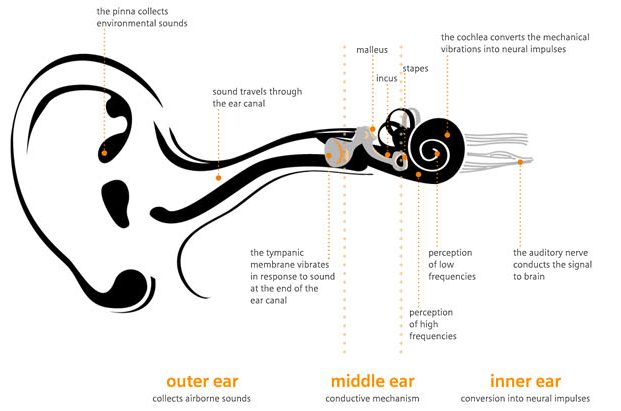
Hearing and Hearing Loss
Years of intensive research have been able to unlock many of nature’s secrets in regard to hearing. Today, this knowledge serves as the basis for the technical development of modern hearing instruments, with the aim of making the natural hearing process as close as possible as the artificial.
How Our Ear Works
Outer Ear
Known as the pinna or auricle, this visible portion of the ear gathers sounds from the surrounding environment and sends it down the ear canal.
Middle Ear
The vibration of the tympanic membrane (eardrum) transmits sound to the inner ear through three small bones (malleus, incus and stapes) that carry sound to the inner ear.
Inner Ear
Made up of two main parts: the cochlea, a system of complex hair cells (sensory cells) and the vestibular system that sends sound to the brain for final processing.

Hearing Loss and Its Effects
If you or a loved one have some degree of hearing loss, you are not alone. Hearing loss affects people of all ages. Globally, over
588 million people have at least a mild hearing loss and 278 million have a moderate to profound hearing loss in both ears.¹ ² A person with an untreated hearing loss risks deteriorating his or her hearing health.
Untreated hearing loss does not only result in increased hearing difficulties over time, it also leads to negative social and personal behavior as communication with others is impaired and self-esteem is affected. A person with untreated hearing loss faces higher safety risks and possibly lower employability. Hearing loss does not just affect the person; it affects family and friends as well.
Hearing loss can be treated with hearing instruments. You may think that wearing hearing instruments would make you look odd. However, hearing loss left untreated may cause others to notice slower responses, constant need for repetition, poorer understanding and mental acuity that may bring much embarrassment.
Hear Better, Live Better
People who have had their hearing loss treated report³:
- better relationships with their family
- better feelings about themselves
- improved mental health
- greater independence and security

How to select your Hearing Instrument
Hearing instruments come in different styles and performance levels. The higher a performance level of a hearing instrument, the more features it has.

Hearing instruments with more features can address listening needs in more challenging situations and are able to deliver a higher level of user satisfaction. Factors which may affect your choice of hearing instrument would be:
• Type and degree of hearing loss
• Listening situations
• Cosmetic needs
• Physical attributes of the ear
• Hand dexterity
• Budget
To select the most suitable hearing instrument for you, you need to discuss with your hearing healthcare professional to identify your hearing needs and listening goals.
5 questions to ask your hearing care professional
- Which hearing instruments are suitable for me?
- Will the hearing instruments be powerful enough if my hearing loss changes?
- What can I expect from the recommended hearing instruments?
- How long would it take for me to get used to using hearing instruments?
- Do I need two hearing instruments?

References:
1. Global Burden of Hearing Loss in the Year 2000. World Health Organization (WHO, 2003)
2. Deafness and Hearing Impairment. World Health Organization (WHO, 2006)
3. The Consequences of Untreated Hearing Loss in Older Persons Summary. The National Council on the Aging (1999)